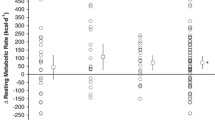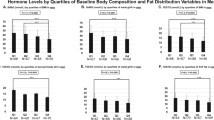Abstract
Excess upper-body (android) fat is considered an health hazard. Exercise training is known to have the potential to modify body composition and to induce a preferential loss of abdominal fat. We studied and compared the composition of whole body and major body regions using dual-energy X-ray absorptiometry (DEXA) in 21 exercising (3–4 hours of intense physical activity/day) and 21 sedentary eumen-orrhoic women of similar ages, body mass index (BMI), waist-to-hip ratio (WHR) and age of menar-che. In a small number of women in each group (6 out of 21), the ACTH and cortisol response to CRH test and the 24-h urinary cortisol excretion was evaluated. Exercising women had 10% higher total and leg lean mass (p<0.05), and 38% lower total fat mass (p<0.01) than sedentary women. Furthermore, the proportion of android fat was 22% lower in exercising than sedentary women (p<0.01), while the proportion of lower-body (gynoid fat) was unchanged. BMI and WHR were not different between the two groups, while the android/gynoid fat ratios were 16% lower in exercising than in sedentary women (p<0.01). In the exercising women, ACTH and cortisol plasma levels, as well as the 24-h urinary cortisol excretion, were significantly (p<0.01) higher than in the sedentary women studied. In these subjects, a direct relationship between the peak Δ percentage increases of ACTH and cortisol after the CRH test and the proportion of android fat was found (r=0.60, p<0.05 and r=0.69, p<0.02, respectively). These results demonstrate that in women who practise intense exercise there are significant differences in body fat distribution in comparison to sedentary women, with a marked less amount of android fat, and suggest that this difference may be related to a reduced response of the pituitary-adrenal axis to CRH.
Similar content being viewed by others
References
Slosman D.O., Casez J.P., Pichard P., Rochat T., Fery F., Rizzoli R., Bonjour J.P., Morabia A., Donath A. Assessment of whole body composition with dual-energy X-ray absorptiometry. Radiology 1992, 185: 593–598.
Pritchard J.E., Nowson C.A., Strauss B.J., Carlson J.S., Kaymakci B. and Wark J.D. Evaluation of dual-energy X-ray absorptiometry as a method of measurement of body fat. Europ. J. Clin. Nutr. 1993, 47: 216–228.
Chilibeck P., Calder A., Sale D.G., Webber C. Reproducibility of dualenergy X-ray absorptiometry. Can. Assoc. Radiol. J. 1994, 45: 297–303.
Bjontorp P. The association between obesity, adipose tissue distribution and disease. Acta Medica Scandinav. 1988, 723: 121–134.
Bouchard C., Despres J.P., Mauriege P. Genetic and non genetic determinants of regional fat distribution. Endocrine Rev. 1993, 14: 72–93.
Pasquali R., Cantobelli S., Casimirri F., Capelli M., Bortoluzzi L., Flamia R., Morselli Labate A.R., Barbara L. The hypothalamic-pituitary adrenal axis in obese women with different patterns of body fat distribution. J. Clin. Endocrinol. Metab. 1993, 77: 341–346.
Hetland M.L., Haarbo J., Christiansen C. Regional body composition determined by dual-energy X-ray absorptiometry. Relation to training, sex hormones, and serum lipids in male long-distance runners. Scand. J. Med. Sci. Sports 1998, 8: 102–111.
Streeten D.H.P. Editorial. Is hypothalamic-pituitary-adrenal hyperac-tivity important in the pathogenesis of excessive abdominal fat distribution? J. Clin. Endocrinol. Metab 1993, 77: 121–134.
Rebuffè-Scrive M., Bronnegard M., Nilsson A., Eldh J., Gustafsson J.A. and Bjorntorp P. Steroid hormone receptors in human adipose tissue. J. Clin. Endocrinol. Metab. 1990, 71: 1215–1219.
Kalkhoff R.K., Hartz A.M., Rupley D., Kissebah A.M., Kelber S. Relationship of body fat distribution to blood pressure, carbohydrate tolerance and plasma lipids in healthy obese women. J. Lab. Clin. Med. 1983, 102: 621–627.
Bjorntorp P. The regulation of adipose tissue distribution in humans. Int. J. Obes. Relat. Metab. Disord. 1996, 20: 291–299.
Wilmore J.H. Body composition in sport and exercise: directions for future research. Med. Sci. Sports Exerc. 1993, 15: 21–31.
Despres J.P., Tremblay A., Nadeau A., Bouchard C. Physical training and changes in regional adipose tissue distribution. Acta Med. Scand. 1988, 723: 205–212.
Andersson B., Xu X., Rebuffè-Scrive M., Terning K., Krotkiewski M., Bjorntorp P. The effects of exercise training on body composition and metabolism in men and women. Int. J. Obes. 1991, 15: 75–81.
Stullkard A.J., Messick S. The three-factor eating questionnaire to measure dietary restraint, disinhibition and hunger. J. Psychosom. Res. 1985, 29: 71–83.
Ley C.J., Lees B., Stevenson J.C. Sex- and menopause-associated changes in body-fat distribution. Am. J. Clin. Nutr. 1992, 55: 950–954.
Despres J.P. Obesity, regional adipose tissue distribution and metabolism: effect of exercise. In: Romsos D.R. et al. (Eds.), Obesity: dietary factors and control. Karger, Basel, 1991, p. 251.
Van Marken Lichtenbelt W.D., Fogelholm M., Ottenheijm R., Westerterp K.R. Physical activity, body composition and bone density in ballet dancers. Br. J. Nutr. 1995, 74: 439–451.
Frisch R.E., Snow R.C., Johnson L.A., Gerard B., Barbieri R., Rosen B. Regional body fat, oestrogen metabolism and ovu-lation of athletes compared to controls. J. Clin. Endocrinol. Metab. 1993, 77: 471–477.
Seidell J.C., Cigolini M., Deurenberg P., Oosterlee A., Doornbos G. Fat distribution, androgens and metabolism in non obese women. Am. J. Clin. Nutr. 1989, 50: 269–272.
Rebuffè-Scrive M. Fat distribution and metabolism. In: Diamond M.P., Naftolin F. (Eds.), Metabolism in the female cycle. Frontiers in Endocrinology 1993, 1: 93.
Rebuffè-Scrive M., Lonnroth P., Marin P., Wesslau C., Bjorntorp P., Smith U. Regional adipose tissue Metabolism in men and postmenopausal women. Int. J. Obes. 1987, 11: 347–355.
Grampes F., Riviere D., Beauville M., Marcuron M., Garriques M. Lipolytic response of adipocytes to epinephrine in sedentary and exercise-trained subjects: sex-related differences. Eur. J. Appl. Physiol. 1989, 59: 249–255.
Peeke P.M., Chrousos G.P. Hypercortisolism and obesity. Ann. N.Y. Acad. Sci. 1995, 771: 665–676.
Villanueva A.L., Schlosser C., Hopper B., Liu H.J., Hoffman D.I., Rebar R.W. Increased cortisol production in women runners. J. Clin. Endocrinol. Metab. 1986, 63: 133–136.
Lytras N., Grossman A., Perry L., Tomlin S., Wass J.A.H., Coy D.H., Schally A.V., Rees L.H., Besser G.M. Corticotrophin releasing factor: responses in normal subjects and patients with disorders of the hypotha-lamus and pituitary. Clin. Endocrinol. 1984, 20: 71–84.
Tegelman R., Johanson C., Hemmingsson P., Eklof R., Carlstrom K., Pousette A. Endogenous anabolic and catabolic steroid hormones in male and female athletes during off season. Int. J. Sport Med. 1990, 11: 103–106.
Loucks A.B., Mortola J.F., Girton L., Yen S.S.C. Alterations in the hypothalamic-pituitary-ovarian and the hypothalamic-pituitary-adrenal axis in the athletic women. J. Clin. Endocrinol. Metab. 1989, 48: 402–407.
Watanabe T., Morimoto A., Sakata Y., Wada M., Murakami N. The effect of chronic exercise on the pituitary adrenocortical response in conscious rats. J. Physiol. 1991, 439: 691–699.
Davis J.M., Pate R.R., Burgess W.A., Slentz C.A. Stress hormone responses to exercise in elite female distance runners. Int. J. Sports Med. 1987, 8: 132–135.
Hohtari H., Lappalainen-Salminen K., Laatikainen T. Response of plasma endorphins, corticotrophin, cortisol and luteinizing hormone in the corticotrophin-releasing hormone stimulation test in eumenorrheic and amenorrheic athletes. Fertil. Steril. 1991, 55: 276–280.
Inder W.J., Hellemans J., Ellis M.J., Evans M.J., Liversey J.H., Donald R.A. Elevated basal adrenocorticotropin and evidence for increased central opioid tone in highly trained male athlethes. J. Clin. Endocrinol. Metab. 1995; 80: 244–248.
Rosmond R., Dallman M.F., Bjorntorp P. Stress-related cortisol secretion in men: relationships with abdominal obesity and endocrine, metabolic and hemodynamic abnormalities. J. Clin. Endocrinol. Metab. 1998, 83: 1853–1859.
Jenkins P.J., Ibanes-Santos X., Holly J., Cotterill A., Perry L., Wolman R., Harries M., Grossman A. IFGBP- 1: a metabolic signal associated with exercise-induced amenorrhea. Neuroendocrinol. 1993, 57: 600–604.
Tataranni P.A., Monroe M.B., Dueck C.A. Adiposity, plasma leptin concentration and reproductive function in active and sedentary females. Int. J. Obes. Relat. Metab. Disord. 1997, 21: 818–821.
Author information
Authors and Affiliations
Rights and permissions
About this article
Cite this article
Fabbri, A., Giannini, D., Aversa, A. et al. Body-fat distribution and responsiveness of the pituitary-adrenal axis to corticotropin-releasing-hormone stimulation in sedentary and exercising women. J Endocrinol Invest 22, 377–385 (1999). https://doi.org/10.1007/BF03343576
Accepted:
Published:
Issue Date:
DOI: https://doi.org/10.1007/BF03343576




